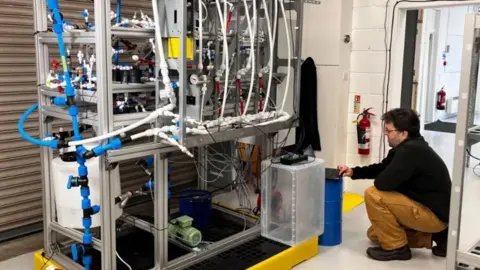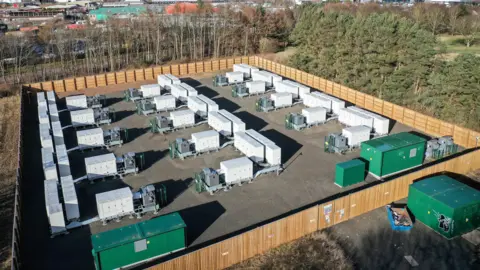How giant batteries will help power Scotland
 BBC
BBCThe number of giant batteries being installed in Scotland is expected to increase dramatically as part of the move towards renewable energy.
Scottish firms are at the forefront of the development of these new technologies - but there are concerns about their impact on local communities.
The National Grid, which transmits electricity around the country, predicts that the amount of energy storage required in the UK will grow almost six times over by the end of the decade.
Huge batteries are needed to store excess power which is being generated from renewable sources like wind farms.
When lots more wind energy is being generated than we are using, it can be stored in these types of batteries ready for use when the wind dies down or demand increases - which usually happens a couple of times a day.

One of the largest battery sites in Scotland is in the West Gourdie area of Dundee.
It can supply the grid with 50 MW of electricity - which is about 4% of the capacity of Torness nuclear power station in East Lothian.
The battery can supply electricity at full power for an hour before having to be recharged.
Operator Flexitricity says that with increasing amounts of Scotland's power coming from renewables, the battery performs an important role in balancing supply and demand.
It should result in fewer occasions where wind farms are having to be switched off - or constrained - because we are not using all of the electricity which is being generated.
Safety concerns
Flexitricity's chief executive Andy Lowe says batteries are becoming increasingly important.
He added: "The wind doesn't always blow and the sun doesn't always shine. You need flexibility on the system to help fill in the gaps."
In 2023, analysts Modo Energy estimated that the total installed battery capacity in the UK was about 3.5 GW.
Forecasts suggest that figure could reach about 20 GW by the end of the decade.
If they were all discharging at the same time, that would be enough to power about 20 million homes - albeit for just a short period of time.
But people living near potential sites have raised concerns about the impact they could have on local communities.

There are proposals for a grid-scale battery site at Eaglesham in East Renfrewshire.
Niall Rachman, who lives nearby, is worried about the fire risk and the potential visual and noise impacts.
He said: "It makes us feel like an industrial town rather than a local village."
Most large-scale sites use lithium batteries. If these are faulty or damaged they can generate excessive heat, creating a phenomena called thermal runaway.
This can cause fires, which are rare but can be difficult to bring under control.
Scottish Fire and Rescue Service is part of a working group which is aiming to better understand the potential risks posed by grid-scale batteries.
It says its "highly skilled" crews have access to a range of resources which would make an area safe in the event of thermal runaway.

St Andrews University is developing battery technologies which have a lower risk of overheating and catching fire.
The Nexgenna project involves replacing lithium with sodium.
This is a cheaper and more sustainable alternative, although at the moment the batteries would weigh more than lithium.
Scientists developing the technology say it would be ideal for grid batteries and that they have already been in discussions with interested companies.
Project manager Dr Scott Lilley expects to see the technology being manufactured this year in China, with the UK following closely behind.
He added: "With grid scale batteries you're not worried about how heavy things are but you are worried about how much it costs and how safe it is.
"Sodium ion batteries have advantages in those areas."

Another alternative technology being developed in Scotland is a flow battery, which works differently to most existing batteries.
An electrolyte liquid physically flows through cells, where a reversible chemical reaction takes place.
The energy is then stored in the fluid at low temperatures, which can be used when the chemical reaction is reversed by flowing the electrolyte back through the cell.
The Edinburgh company behind the project, StorTera, says the flow battery is better for long duration energy storage.
The National Grid classes long duration as anything greater than four hours.
With the amount of offshore wind energy expected to expand by a factor of 13 in the coming years, that long-term storage will grow increasingly important.
The company plans to deliver a scaled up demonstrator of its flow battery this year - but the UK government is still to make a decision on how such storage will be funded in the energy market.
Brenda Park, from StorTera, said they could be housed at wind farms, which would reduce the amount of excess energy being wasted.
She added: "As the business case improves, there's going to be a lot of demand for batteries like this in the future."
